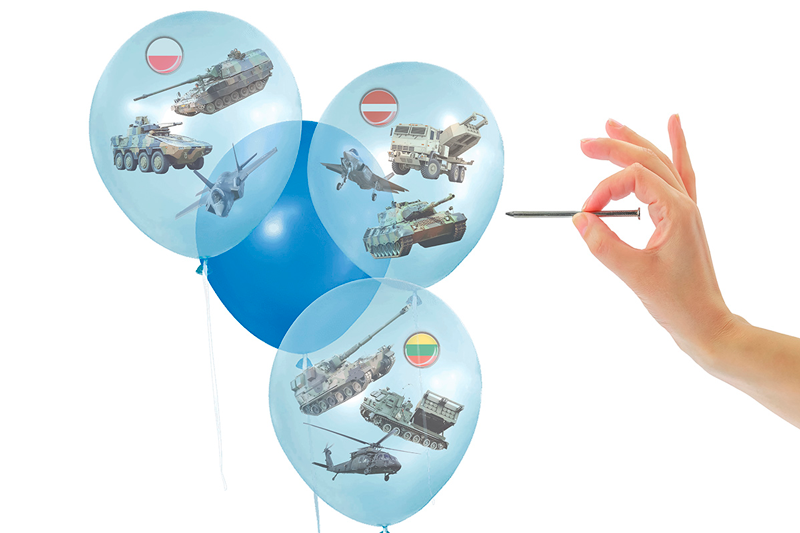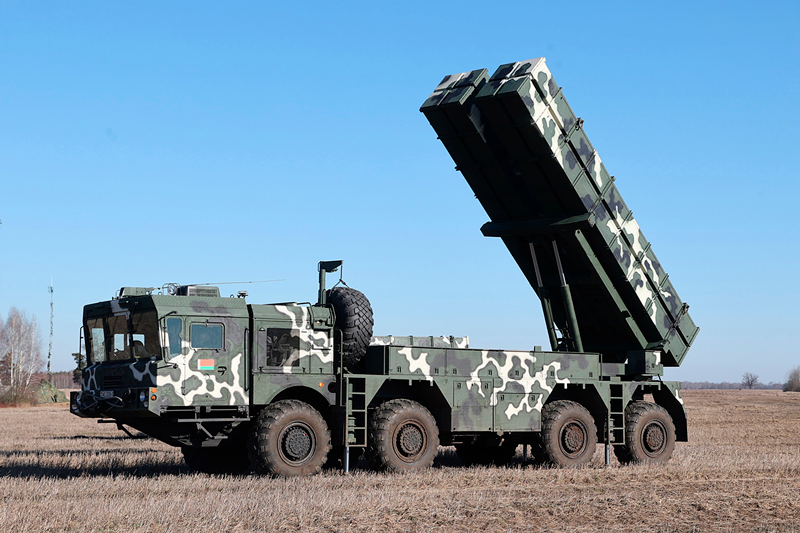Frowning "Leopards" and "Krabs"
Militarization of neighbors near the Belarusian borders continues, but Belarus is ready to defend its sovereignty
The situation at the Belarusian border continues to escalate: the Ukrainian military deployed a 15,000- strong group at the southern borders, and NATO is increasing its military presence on the western side. A combat brigade group (more than 700 combat vehicles, including tanks, infantry fighting vehicles and armored personnel carriers) from the US 1 st Infantry Division arrived at the Polish naval base in Gdynia. After unloading, the unit was transferred to the eastern borders of Poland to conduct combat coordination with parts of the Polish Army. Moreover, two more combat brigade groups from the same division are expected to arrive in Poland early this year. So, what is happening in the neighboring countries and what are the threats of the military preparations of the North Atlantic Alliance to our country?
President of Belarus Alexander Lukashenko:
— We must honestly include the risks, threats that exist, and how we respond to them. So that both neighbors and others know how we will react. In order not to say that it was a surprise for someone. There is nothing to hide. Everything must be done honestly. If we are with Russia, then we are with Russia. We have created a defense space, we have a common armed forces in fact (our army is at the forefront). The regional grouping is operating. And let no one criticize us there and make some kind of fake or extraordinary statements, like "oh, oh, there's ¬Lukashenko, Russian troops, and so on". Is that so surprising? We declared this a long time ago. It's been about 20 years since we agreed on this.
During a meeting with the State Secretary of Belarus' Security Council Alexander Volfovich, September 20, 2022.

Is war peace?
Speaking about the Eastern European region, it should be noted that all our neighbors from the NATO bloc continue not only to provide full military assistance to Ukraine, actively supporting overseas anti-Russian and anti-Belarusian rhetoric, but also systematically increase their combat power and offensive capabilities. This is clearly evidenced by the conceptual documents of constructing and developing the national armed forces of Poland and the Baltic States.
Currently, the full staff of the Polish Armed Forces is about 114 thousand people, which, by the way, is almost twice as much as in Belarus. By 2025, the Poles plan to increase this number to 250 thousand, and this, remember, is the number of the peacetime army.
Moreover, during the construction of the Armed Forces, it is planned to supply the troops with highly offensive types of weapons – the recent 5th Gen F-35 fighters, Leopard tanks of various modifications, Himars multiple rocket launchers, Krab 155 mm self-propelled howitzer. At present, regular Polish units are fighting in Ukraine on this equipment under the guise of mercenaries. In the future, until 2025, the Poles plan to modernize and replace 95 percent of the weapons fleet with new models. Just think about it — 95 percent!
Definitely, increasing of national armed forces and the purchase of modern weapons are impossible without significant financial injections.
And if in 2022 Poland's defense budget was zł58 billion (about $12.3 billion, which is 2.2 percent of GDP), then this year it is planned to allocate a record zł98 billion for national defense (about $20.8 billion –3 percent of GDP).
One more example emphasizing the purely "defensive" Polish doctrine. Currently, all units and subdivisions of the Polish Border Guard stationed within the border zone (up to 30 km deep) have been replaced by formations and military units of the national armed forces with means of intelligence and heavy weapons. Why concentrate the striking force in the immediate vicinity of our borders? This is a rhetorical question.
The Baltic states aren't far behind. For instance, the main directions of constructing Lithuanian armed forces are to increase their number to 30 thousand people (with their territory and population!), as well as increasing the combat potential. In particular, we are talking about the purchase of modern weapons (foreign-made, since they do not have their own military-industrial complex in principle) – Black Hawk multirole helicopter, the latest Boxer armored personnel carriers, PzH 2000 self-propelled howitzers, Himars and MLRS multiple rocket launchers, armored vehicles of various modifications. The first contract for Himars battery supply to Lithuania was signed on December 16.
Last year, due to the "threat from the East", the Lithuanians increased military spending by almost €300 million! And their defense budget reached a record high of 2.52 percent of GDP instead of the planned 2.05 percent.
Latvia, despite a smaller military budget compared to its neighbors, also continues to actively reorganize the national armed forces and by 2025 is going to increase their number to 15 thousand people, also with a mandatory offensive component. For this purpose, the country is purchasing modern artillery systems and armored combat vehicles, and it is planned to bring defense spending from 2.05 percent in 2022 to 2.5 percent of GDP by 2025.
The presence and constant buildup on the territory of Poland and the Baltic states of NATO combat groups, and first of all the U.S. groups (more than 37.5 thousand people as of December 1, 2022) with heavy offensive weapons, proves once again the preparation of the North Atlantic Alliance for a purely "defensive" war.
BY THE WAY
The Polish armed Forces are about to order another 70 thousand Grot assault rifles of their own production, which they started to develop in 2007 to replace the Kalashnikov. Designers and the military claim they were able to correct the initial shortcomings, and the decision to purchase a new large batch was made, among other things, based on the experience of the Armed Forces of Ukraine: Warsaw sent an unnamed number of machine guns to Kiev last year.
Polish Defense Minister Mariusz Błaszczak said: "These rifles have won recognition from the soldiers of the Polish Armed Forces, as well as soldiers of the Ukrainian troops. This design had been criticized, but in the end it proved its suitability, proved itself in battle, that is, the Grot rifle has passed the most important exam".
Confronting the threat together
Threats to the military security of the Union State dictate the need to consolidate joint efforts of Belarus and Russia to counter challenges in this area. In response to the far not peaceful policy of the neighbors, the Armed Forces of Belarus, including as part of a Regional grouping of troops (forces), have to systematically increase their combat power, are now aligned with the risks, challenges and potential threats to the military security of the state.
Based on the World Military Strength Ranking published annually by the Global Firepower international analytical organization, the Belarusian Armed Forces rank 39th in the list of the strongest armies in the world. Although only three years ago we ranked 49 th. Among CSTO member states, the Belarusian army is the second after Russia in terms of its combat potential and combat power.
In addition, judging by the statements of a number of Western analysts, the Belarusian army is one of the most armed and combat-ready in the Eastern European region.
The increase of combat capability of the national Armed Forces became possible thanks to the competent policy of the country's military and political leadership and the personal participation of Alexander ¬Lukashenko in addressing issues of ensuring military security as an integral part of the national security of the state.
The tasks of improving and modernizing weapons samples, supplying the necessary equipment to the troops were clearly formulated by the Commander-in-Chief earlier. Also, the task was to develop, design, and produce domestic weapons. By the way, Belarusian arms makers have a lot to be proud of.
We have developed one of the best in its class "Polonaise" missile system, which is in service with our Armed Forces, we build modern unmanned aerial systems, communications, air defense and electronic warfare systems, armored vehicles and robotic systems. Many samples of Belarusian weapons are exported.
The combat potential of the Belarusian Armed Forces is also increasing due to close military-economic and military-technical cooperation with the Russian Federation. Only in recent years, contracts have been concluded and the troops are being supplied with modern T-72B3M tanks, combat and combat training planes Su-30 and Yak-130, multi-purpose helicopters of various classes, as well as anti-aircraft missile systems. A typical example of this is the delivery of two S-400 and Tor-M2K air defense missile system to the troops in December, as well as the Iskander missile system.
A worthy response to modern challenges
In addition, we are constantly improving the national air defense system. And, by the way, Western analysts noted that in terms of the number of modern S-300 air defense systems, as a percentage of the total number of anti-aircraft missile systems, we have taken the lead in the world.

Of course, if a military conflict begins, the Armed Forces of Belarus will not meet it alone. We are bound by agreements within the framework of the Union State with our Russian colleagues. Our brothers in arms from the Collective Security Treaty Organization will also support as. All of this together is quite a powerful and formidable military force. In order to increase the effectiveness of using heterogeneous groupings of troops, we constantly conduct various interstate operational and combat training activities.
All said gives reason to believe that Belarusian Armed Forces at present are ready and able to fully and under any circumstances perform the tasks of armed defense of the country, its sovereignty, independence, constitutional order and territorial integrity.


